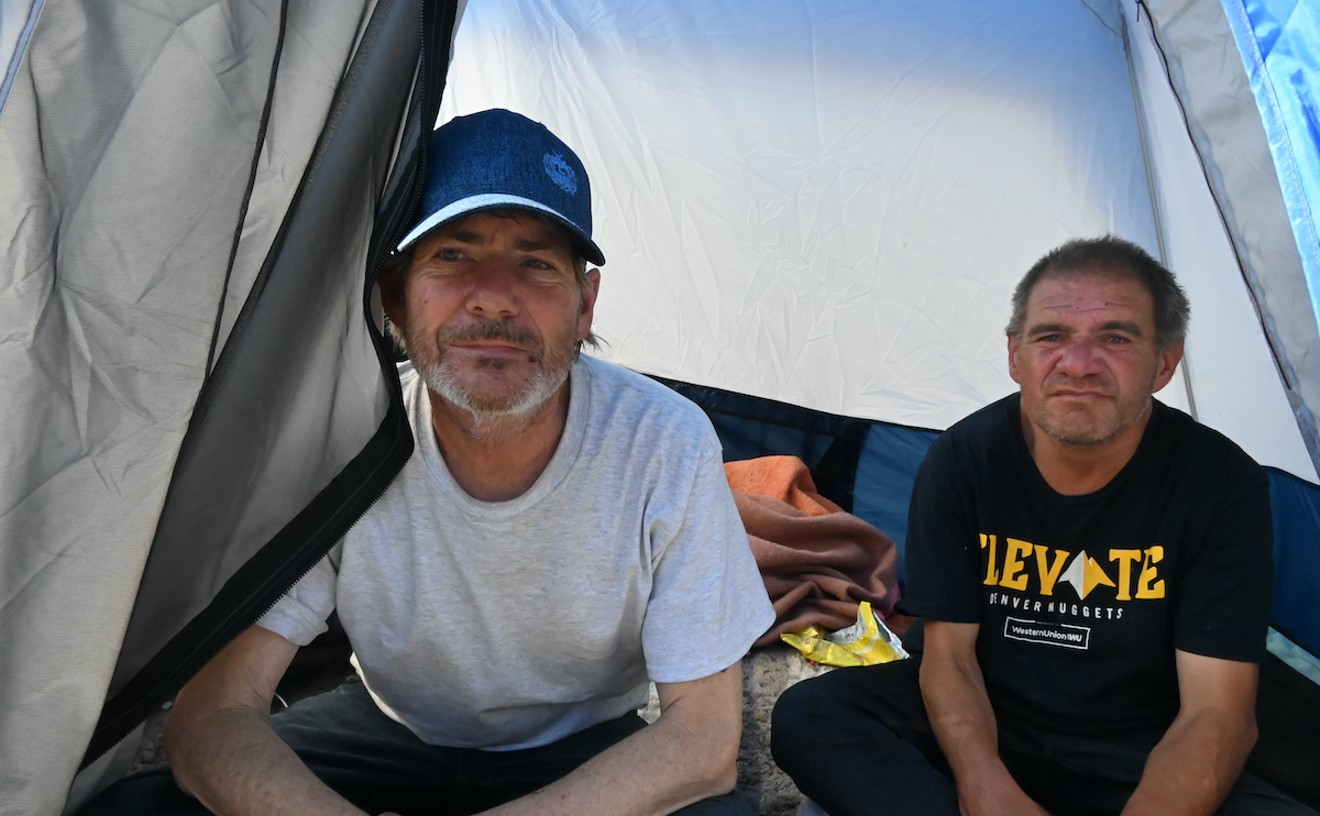But in January, her bosses at Alice gave her the heave-ho as part of a cost-cutting move by Indianapolis-based Emmis Communications, which owned the outlet at the time -- and despite her skills and the high esteem with which she's held in the local radio community, she's yet to find anything new.
"It's really tough for talent right now," Selby concedes. "There are fewer and fewer jobs out there, and more people looking for them."
A big reason for that is voicetracking, a technique in which DJs record their contributions in advance for subsequent placement in broadcasts. A primitive version of this system debuted in Colorado in 1992 courtesy of Rocky Mountain Radio Network, which interlinked stations in Vail-Avon, Aspen, Hayden, Gunnison and Sun Valley, Idaho. At the time, the notion that a single jock could helm shows at six stations simultaneously, as was commonplace on RMRN, was so startling that industry publications Billboard and Radio Ink both profiled the firm.
But by decade's end, many of the country's larger radio ownership groups had adopted the method, and voicetracking stars began to develop. One such secret celebrity was Brian Christopher, nicknamed B.C., whose 7 p.m.-to-midnight weekday show on the Fox, Denver's most popular classic-rock station, actually originated in Panama City, Florida ("Live From Denver -- Almost," December 16, 1999).
Today B.C. can still be heard on the Fox from his Florida studio, albeit at a different time, 3 to 6 p.m. weekdays. But his program is hardly the only one on the station that utilizes voicetracking. Lamont & Tonelli, the Fox team heard in Denver from 8 to 11 p.m., is actually the early crew on KSJO, which serves San Francisco and San Jose. And that's not to mention the so-called "second shift" of Fox regulars Rick Lewis and Michael Floorwax; their live morning program is compressed to two hours in length and rebroadcast weekdays beginning at 6 p.m.
Why do so few listeners realize how commonplace voicetracking has become? For one thing, the computers and other assorted doodads that make it possible have improved exponentially since the early '90s, virtually guaranteeing a seamless presentation. Moreover, the approach isn't quite as impersonal as satellite broadcasting, in which programming is beamed from a central location to distant branches (and now to individual drivers); it allows DJs to tailor material for each locale, thereby giving listeners in towns big and small the illusion that the person they're hearing is speaking to them live from nearby when that's often not the case.
In addition, voicetracking gives jocks the tools to complete multiple shows for assorted markets during the span it previously took to make only one, thereby saving a considerable amount of money for stations. Gregg Stone, better known to listeners of hard-rocking KBPI as Uncle Nasty, is among the most in-demand voicetrackers in Denver; he says he gets paid about one-third of what a DJ in a given market would receive for each station he voicetracks for.
Whether voicetracking results in better radio is a subject of debate. But there's no doubt that the practice has resulted in fewer DJs being heard from coast to coast. During overnight periods and on weekends, in particular, live broadcasts are becoming rarer than an uncooked steak. Selby laments this fact. "If it's snowing on Sunday morning, voicetracking isn't going to tell you that," she notes. "And if you want to go mountain biking and you want to know about traffic on I-70, voicetracking won't give you clue one. There's the basic expectation among listeners that there's a live DJ on that box when they're listening to you; they don't expect you to be recorded. But a lot of times, you are."
Mike O'Connor, director of FM programming for Clear Channel Denver, concedes that point. But in the age of media consolidation, he has to deal with economic realities -- and the fact remains that Clear Channel, which lost over $365 million in 2001's fourth quarter despite an enormous portfolio that includes 1,200 radio stations, has stockholders to satisfy. "Wall Street drives all of this," he says. "It's about reducing costs and improving operating margins. There are two ways to do that: You could fire all the disc jockeys and segue into music, or you can use technology to make better talent go further. And we believe that a great talent in Denver can be a great talent in Tampa."
Examples of this philosophy abound among Clear Channel types in these parts. For instance, JoJo Turnbeaugh, known here for his work on KISS-FM, voicetracks stations in Fargo, North Dakota; Waco, Texas; and Atlanta. Even busier is Robbie Knight, midday host for the Fox, who does imaging, or station promotion, for outlets in Grand Forks, North Dakota, and Baltimore, and also supplies programs for stations in Albuquerque; Medford, Oregon; Asheville, North Carolina; and Santa Maria, California.
O'Connor feels that people like Turnbeaugh and Knight can't help but upgrade the quality of many signals, especially ones in smaller markets. "The depth of talent available to radio has always been shallow," he says. "One out of every ten jocks has that superstar status, and the rest just play tunes. Those types of jocks can be valuable, but they're not unique or indispensable. With voicetracking, though, you can bring one of those superstar jocks to a station that never could have afforded it otherwise, instead of hiring just another jock."
In O'Connor's view, Stone should be included in the top 10 percent of DJs, and he's correct. The prototype of a good, hard-rock jock, Stone is rebellious and politically incorrect enough to appeal to the younger end of the head-pounding demographic without insulting the intelligence of folks with a touch of gray who still appreciate a good power chord. No wonder his ratings during the afternoon drive are among the highest garnered by anyone at KBPI.
In short, Stone is just the type of host that other stations would love to employ -- and now, thanks to voicetracking, they can. He continues to put together his KBPI block the old-fashioned way: Monday through Friday, he actually plays songs, gabs with callers and cracks jokes live alongside his faithful producer, Lynne Ryan. But prior to (and sometimes after) entertaining Denverites stuck in I-25 gridlock, he also assembles shows for five additional Clear Channel stations: KMOM, "the mother of all rock stations," in Colorado Springs; KZRR, also known as "94 Rock," in Albuquerque; classic-rocking KRZZ in Wichita, Kansas; XEPR, dubbed "The Bandit," which is physically located in Mexico but serves El Paso; and, most impressive, KLOL, a classic rocker that's among the most-listened-to rock stations in Houston, the country's ninth-largest radio market. (Denver-Boulder comes in at number 22.)
For Stone, learning how to do long-distance radio was a challenge, especially given his devotion to localism. Too many of his colleagues pay no attention to the area music scene, but he's an active supporter of homegrown sounds, energetically touting groups like Rogue, Rocket Ajax, Sick and ThroCult, and even leading an act of his own, A Band Called Horse. He also peppers his shows with references to area events -- a habit that gets complicated when such happenings aren't in his back yard. Then again, putting together six radio shows a day is tricky under any circumstances.
"I get here between ten and eleven and go through e-mails and voice mail," Stone says. "Then I get together with Lynne and we look at national stories: stories we can use in every market, including Denver, and also music information like notable days -- Jimi Hendrix's death, Randy Rhoads's death. A lot of death. Then we go through stories for individual stations, looking for something that stands out -- and in some of these markets, nothing fucking happens. You're lucky if once or twice a week, shit happens that you'd want to talk to the rock audience about. But I do the best I can. Then I compile all my stories and write everything down for each market, laying out my plan. It's like a map that shows how many breaks I do an hour at what station, and I figure out what bits I can plug in where.
"After that, I do the national breaks," he goes on. "I used to do each of them six times, but my voice couldn't take it. Now I do them once and take out the call letters for whatever station it was from the beginning so we can put other call letters in on the other side. Then I record all my other bits and start inserting them for each of my stations. I do Albuquerque in about 45 minutes -- done. Another 45 minutes for El Paso -- done. And so on until everything's done."
Mass production on this scale can lead to awfully generic radio, and Stone says he knows of some voicetrackers who "just assembly-line it." But because he takes pride in generating good ratings in each of his markets ("It would bother me personally if I wasn't top three everywhere I'm at"), he does his damnedest to give everything he's got: "You have to say those call letters with passion, and you have to put a hundred percent of you into every bit you record, every time."
He's gotten so good at doing so at his six current stations that he thinks he might even be able to keep a couple more balls in the air. "If I hired somebody to help out," he says, "I could probably handle doing eight."
With other voicetrackers working just as hard to expand their reach, fledgling DJs are finding it awfully hard to get a shot on the air unless it's through the side door. "The new and upcoming teams of radio's future are generally working in the promotions department setting up banners, parking the van on the street, doing remotes from car dealerships," says Clear Channel exec O'Connor. "They break in, and a number of them get to do part-time weekend voicetracking shows."
O'Connor points to Brian Degrasse, dubbed Wingnut, who started as an intern, developed a following during guest appearances on KBPI's morning show, The Locker Room, and now voicetracks the occasional Saturday or Sunday shift on top of his daily duties as promotions director for the Fox.
Of course, the number of behind-the-scenes jobs is shrinking, too, forcing even high-profile radio pros to consider leaving the profession entirely. Take Chuck Woodford, who worked at KBCO from 1990-1995 before jumping to the Peak. He was heard at the latter during assorted slots, including a stint in morning drive alongside Selby, before the station changed formats in 1998 from adult rock to heavy alternative and Howard Stern. When no suitable radio gigs opened up, Woodford concentrated on television, working in various capacities on programs that have wound up on Fox Sports Net, ESPN and the Food Network. But he still loves radio, and about a year ago, he returned to the Peak to do weekends and fill-ins -- and in December, following the departure of DJ Sam Stock, he was handed the 7 p.m.-to-midnight shift. "It looked like I would go full-time as soon as they finalized the budget," Woodford says about the station, which, like Alice, was owned by Emmis Communications. "But then they sold the station."
True enough, Emmis peddled the Peak to Entravision Communications, which immediately announced that it would ditch the station's '80s-rock-oriented style in favor of Spanish-language material shipped via satellite from California ("Interpreting the Signals," February 28). The move left Woodford to serve as the Peak's evening nursemaid until the switch is finalized -- and given the present state of radio, symbolized by the unemployment awaiting the Peak's entire staff, he's not optimistic about finding another job behind the microphone anytime soon.
"Five years ago, I couldn't have predicted the paradigm shift, the massive philosophical changes in the way music and information is presented on the radio," Woodford says. "Most radio stations have done away with news staffs and community service staffs. At the Peak, we used to have a really good organization that went out and got involved with local communities, but it doesn't exist there anymore...but groups like that don't really exist anywhere anymore."
To Woodford, the spread of voicetracking is the next logical step in this process. "I understand the need for talented air staff," he says. "But when they find someone talented, they turn him into a representative for several stations, farming him out to other towns. And in those towns, anybody who wants that job is just hosed."
Live on Memorex: As divulged in our recent look at Colorado Public Radio ("Going Public," February 21), CPR uses voicetracking techniques as a matter of course; only pledge drives usually feature live content. However, as numerous readers have pointed out, not all of CPR's pleading occurs in real time either. CPR spokesman Sean Nethery estimates that 60 to 70 percent of the pitches for funds are live, with the rest being recorded. Based on the time I spent listening to the network during February's winter campaign, I'd put the percentage at closer to fifty-fifty, and others imply that Nethery's figures should be reversed. One correspondent remembers hearing a supposedly impromptu exchange between announcers at least twice; he could tell because the giggles were in exactly the same places.
Spontaneity is a lot easier to deal with when you know it's coming.
The Chuck report: While reading columns by the Denver Post's Chuck Green, which I do for the same reason that people attend stock-car races (we love the mayhem), I've noticed that he often needs to s-t-r-e-t-c-h topics to fill his designated space. But seldom has his desperation been so evident as it was in two columns last week.
In March 11's "Glad Frank's Finally Gone," about the demise of death row inmate Frank Rodriguez, Green upped his word total by typing and retyping "dead" -- as in the clever sentence "He is dead, dead, dead" and the even pithier "Dead, dead, dead." By my count, the Greenster managed to fit a whopping thirteen "dead"s into that piece.
But judging by March 13's "Yates Verdict Fitting? You Bet," a reaction to the conviction of Houston's Andrea Yates for drowning her five children, his thirst for repetition was not yet slaked. Ten more "deads" popped up in two big lumps, the second of which read, "And yes, you knew that what you were doing was wrong, and that is why you called the police when it was over -- when they were dead, dead, dead, dead, dead." (You can practically hear him counting them out, can't you?) Then, to prove he's not a one-trick pony, Chuckles used "sick" eight times, highlighted by, "You knew what you were doing, even though you were sick, sick, sick."
When I read that line, I couldn't help but laugh, laugh, laugh, laugh, laugh.











